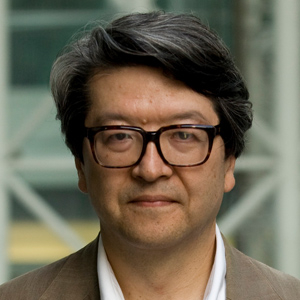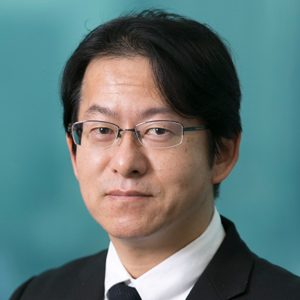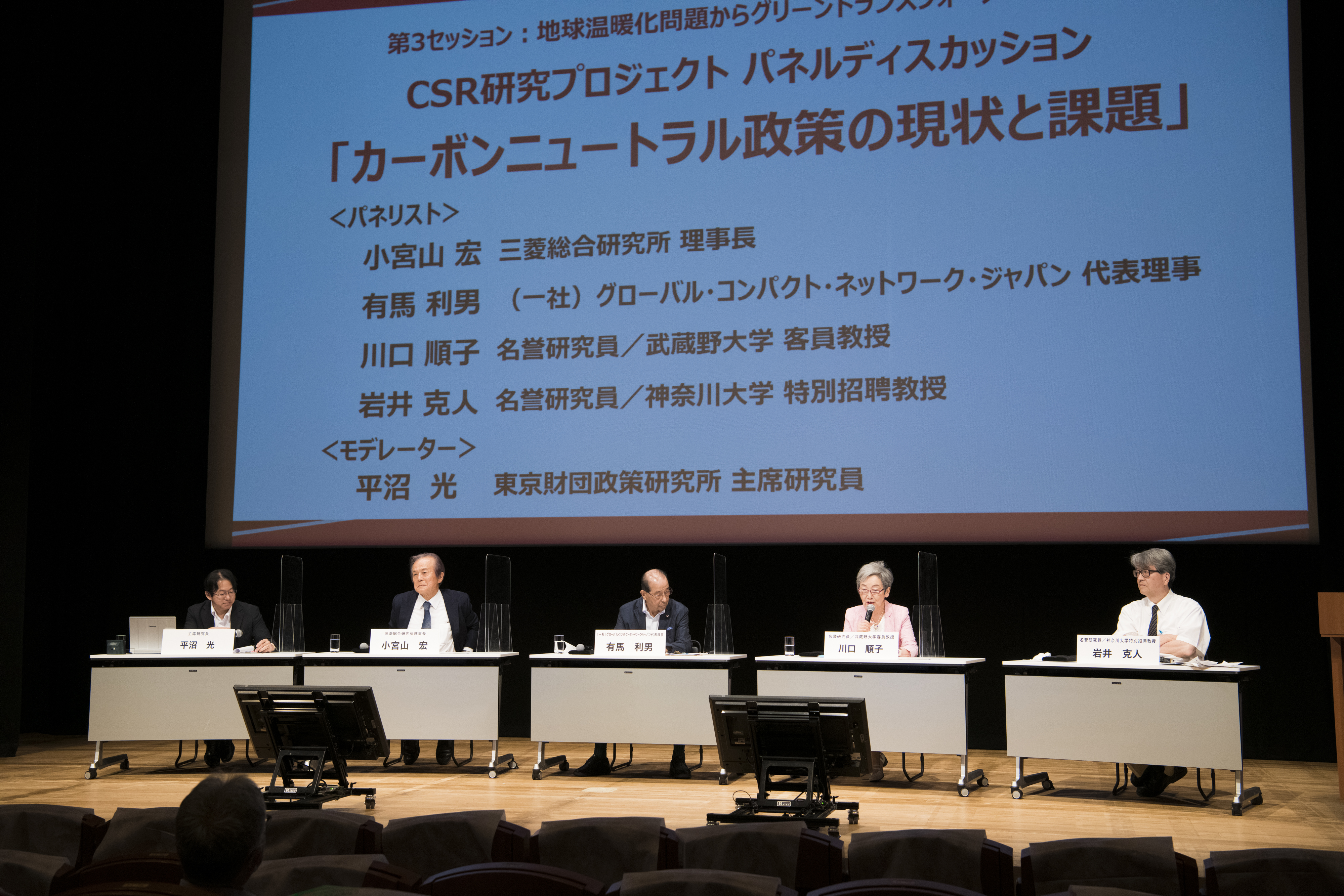
The Tokyo Foundation for Policy Research hosted a symposium on July 22 to showcase its updated lineup of research programs, many of them launched in October 2021. Here, members of the CSR research project’s Committee of Experts discuss the main sustainability issues confronting Japan and the world.
* * *
At the UN Climate Change Conference in Glasgow (COP26), held in October–November 2021, the parties to the UN Framework Convention on Climate Change acknowledged the importance of limiting the long-term increase in the average global temperature to 1.5°C above pre-industrial levels, rather than “well below 2°C,” and agreed to pursue efforts toward the more ambitious target. As of November 2021, some 150 countries, representing 82% of global carbon dioxide emissions, had adopted timetables for achieving carbon neutrality. But the fallout from Russia’s invasion of Ukraine, launched in February 2022, has destabilized energy supply and demand, raising new doubts about the likelihood of meeting those targets. With these concerns in mind, the Foundation’s CSR research project held a round table on carbon neutral policy (its current state, issues, and prospects) and corporate responsibility. The following is a summary of the presentations and remarks delivered by the Foundation’s Committee of Experts.
PRESENTATIONS
Hiroshi Komiyama
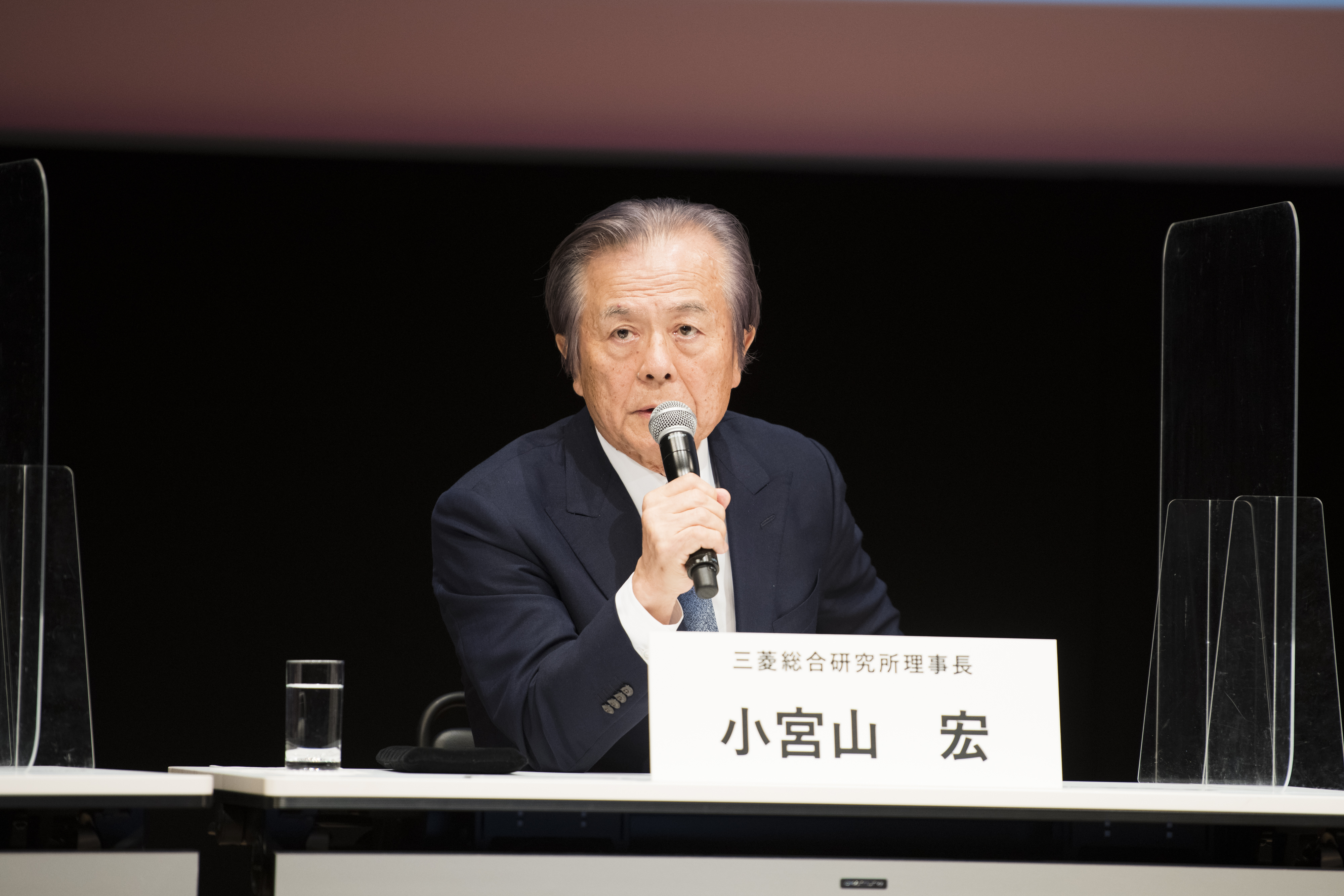
Global warming emerged as a serious challenge facing humankind in the late 1980s, and the actual pace of global warming has surpassed scientists’ predictions in the intervening years. The solution is clear: Fossil fuels must be essentially abandoned. Of course, we hear talk of technologies like direct air capture (DAC), which removes CO2 from the air and submerges it in the ocean, along with the possibility of capturing carbon before it enters the atmosphere. And given the slow pace of progress, such supplementary approaches are going to be needed as well.
They cannot be our main strategy, however. Not using fossil fuels must be the core of any realistic plan to achieve carbon neutrality. It’s fair to discuss the role of nuclear power, but even at its height, nuclear power provided only 5%–6% of the world’s energy. So, our focus must be on how to transition from fossil fuels to renewable energy. There’s no shortage of renewable energy; the sunlight that reaches the earth provides 5,000 times more energy than that used by all of humankind.
But we need to achieve sustainability in material resources as well as energy. In-use stocks of metals are already saturated in the world’s industrially developed countries, and global stocks are expected to be saturated by around 2050. From 2050 on, therefore, the obvious solution for metals is to recycle existing stocks. Plastics can’t be done away with, but we can start making them out of biomass created through photosynthesis. The definition of sustainable development is development that meets the needs of the present without compromising the ability of future generations to meet their own needs. To achieve sustainability, it’s vital that we stop relying on fossil resources created by photosynthesis in the remote past and meet our present needs using the products of present-day photosynthesis.
The shift to such an economy will be advantageous for Japan, which has no oil or natural gas reserves of its own. We can replace the oil we import from overseas with domestically sourced renewable energy, and the money now spent importing resources like iron ore can be channeled into our own economy. Furthermore, Japan, with its warm, humid climate, has excellent conditions for photosynthesis. With these advantages, Japan’s future looks bright, and we should be working hard to accelerate the transition. Yet in fact we are lagging behind much of the world. The big challenge now is to build a consensus for change among the public and private industry.
Toshio Arima
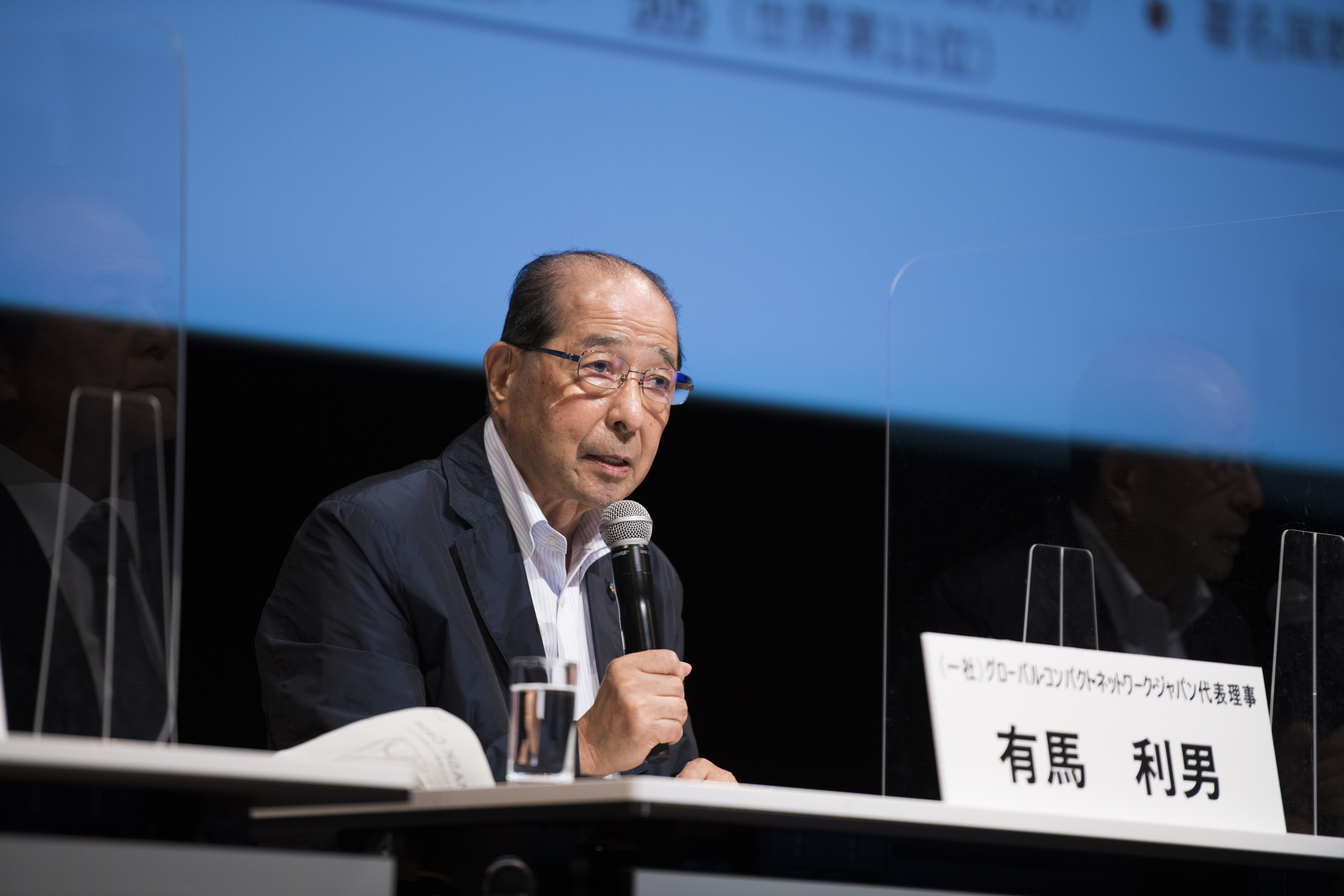
Numerous initiatives are underway around the world to achieve carbon neutrality and fight global warming, and Global Compact Network Japan, of which I serve as chair, is part of that effort. GCNJ is a partner of the UN Global Compact, a worldwide network of companies working with the United Nations to support sustainability. The UNGC began with a proposition that Kofi Annan, then UN secretary-general, put to global business leaders at the 1999 World Economic Forum in Davos. Annan proposed nine principles for sustainability, grouped into the three areas of human rights, labor, and the environment.
This initiative came against the background of economic globalization, which had made rapid strides following the collapse of the Soviet Union and the end of the Cold War in 1991. Globalization fueled corporate growth and expansion but also a host of social problems, such as child labor, human rights violations, corruption, and deforestation. Annan called on businesses to enter into a compact with the United Nations and become part of the solution instead of part of the problem. The UNGC was formed the following year.
With the signing of the UN Convention Against Corruption in 2003, anti-corruption was added as a fourth category, creating the current framework of 10 principles in four areas. As of this time, 161 countries have signed the compact, and there are local networks in 71 countries. Japan’s own network, GCNJ, was established in 2003, and it now boasts more than 500 companies and other organizations as its members.
In addition to the UNGC, Annan proposed the Millennium Development Goals (MDGs), which preceded the UN Sustainable Development Goals, or SDGs. In 2005, to spur industry to action, he enlisted institutional investors in a process leading to the adoption of the Principles for Responsible Investment based on ESG (environmental, social, and governance) criteria. In 2011, the UN Human Rights Council unanimously adopted the Guiding Principles on Business and Human Rights. Through these initiatives, Annan sought to give a human face to the global market.
Each year, GCNJ carries out a survey to monitor progress toward the SDGs. One of its findings is that Japan is making very slow progress in fighting climate change (Goal 13).
Yoriko Kawaguchi
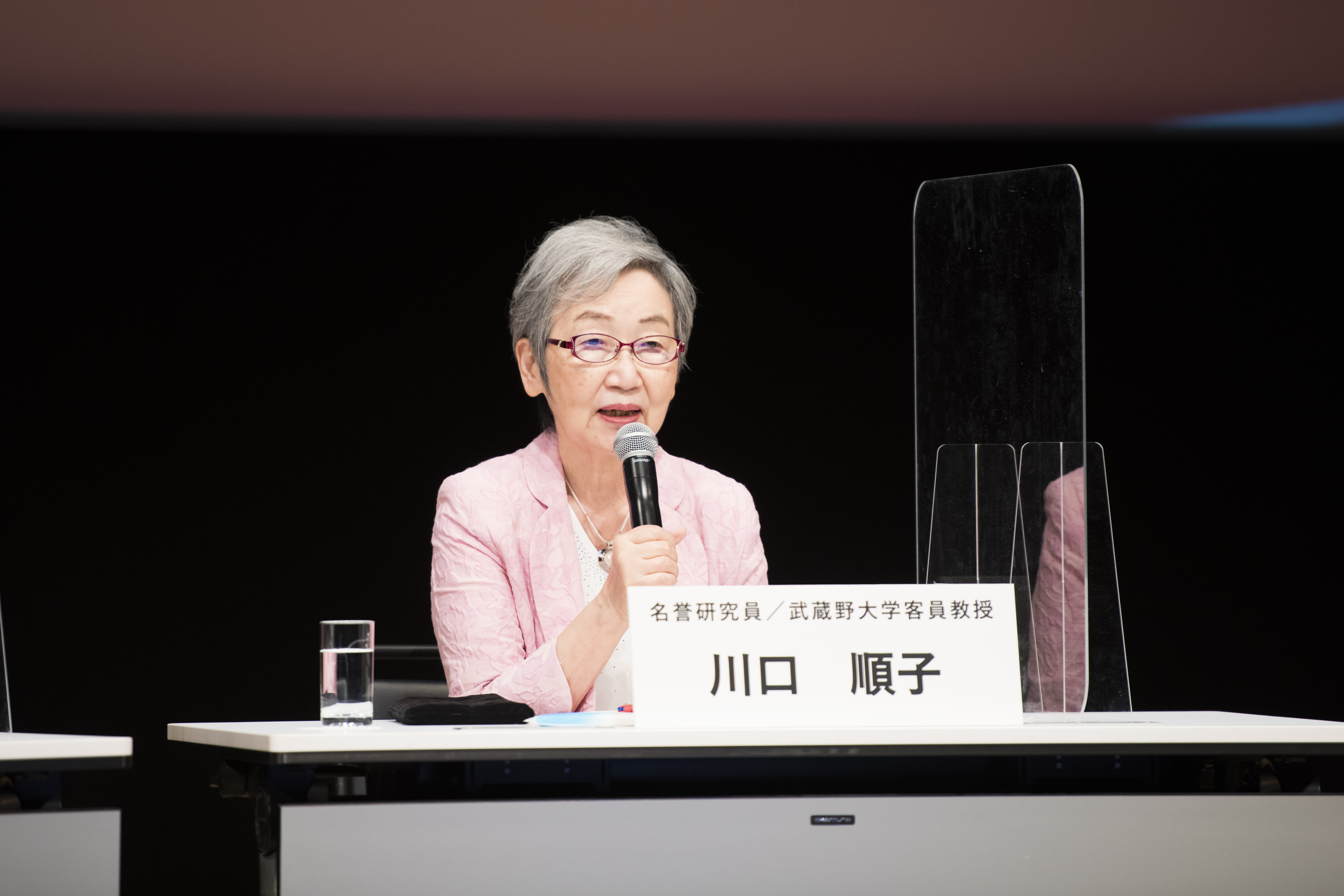
According to a recent study by Professor Shuzo Nishioka of the National Institute for Environmental Studies, the maximum volume of carbon emissions that will permit the earth’s temperature to stay within 2°C of preindustrial levels is roughly 30 years’ worth, based on 2010 levels. There has been a lot of talk about the way the war in Ukraine is forcing countries to use fossil fuels, and many people seem to think that the effort to limit the temperature increase to 2.0°C—never mind the 1.5°C target—is stalled. For the developing world, the targets may be difficult to achieve. But in the industrialized world, particularly the European Union, there is a lot of optimism that, with energy costs soaring, we have a rare opportunity to pursue decarbonization. In this context, expectations on industries are very high.
As Mr. Komiyama pointed out, we now have a good idea of what needs to be done. Industry, which has the financial, technological, and human resources to do it, will need to play the biggest role in decarbonization. In terms of legislative and regulatory systems, the EU is leading the way, and changes in the EU’s 400-million-strong market will have a major impact on the rest of the world. But only a minority of Japanese businesses view the drive for carbon neutrality as a business opportunity, according to the CSR research project’s corporate survey. This is most regrettable, and it does not bode well for Japan’s future.
Today, the idea of a circular economy is in the spotlight. Eight material resources (steel, aluminum, plastic, cement, glass, timber, primary grains, and beef cattle) account for 20% of greenhouse gas emissions, 95% of water use, and 88% of land use. In the energy sector, we can do much through improvements in energy efficiency and the use of renewable energy, but along with those initiatives, we need to achieve a circular economy through the 3Rs (reduce, reuse, and recycle), combined with the use of renewable resources and advances in production technology.
In the EU, building a circular economy is an important pillar of the European Green Deal, and internationally, talks have begun on a global treaty to end plastic pollution. Japan has also accorded a prominent place to the circular economy and has passed legislation to promote the recycling of plastics. Meanwhile, the EU is deliberating the idea of digital product passports to facilitate the transition to a circular economy. Until now, it has been largely up to the supply side to save on energy and resources, but digital technology promises to empower consumers by providing direct access to detailed product information.
In terms of policy, the first priority for Japan should be the introduction of a carbon pricing mechanism. China and South Korea have already established emissions trading schemes, and discussions about linking the two carbon markets are underway. Japan is straggling in this regard. The second priority should be building a circular economy. Japan needs to approach this from the perspective of securing scarce resources as well as stemming global warming. The third priority should be the development of green infrastructure. This past summer, Tokyo was on the verge of a blackout. We should be asking why there are still interconnection links between Honshu and Hokkaido.
Katsuhito Iwai
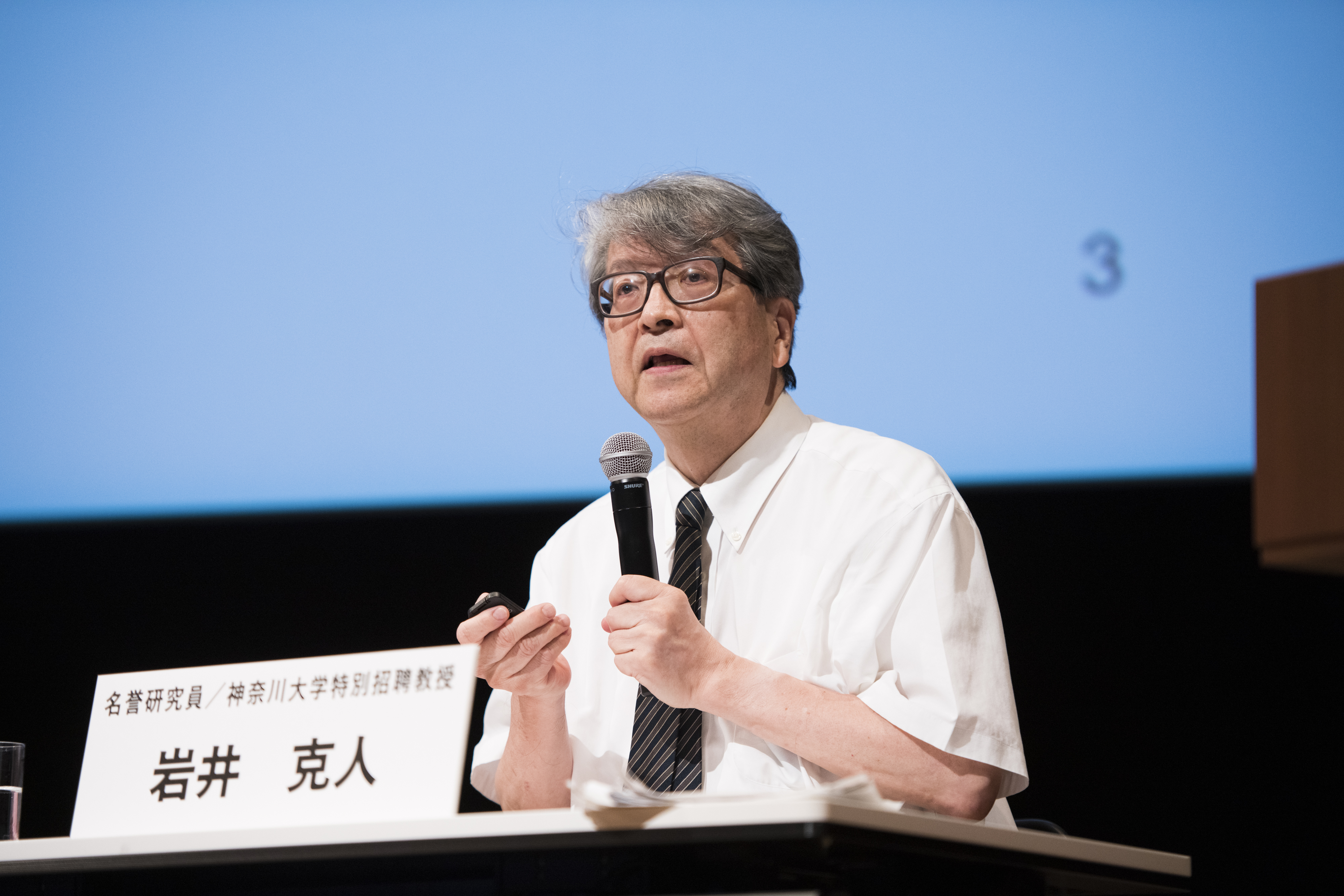
The purpose of the Foundation’s CSR research project is to promote industry’s transformation from the cause of social problems to the source of their solutions. CSR, which stands for “corporate social responsibility,” refers to corporate action aimed at the achievement of social goals, such as the SDGs. But there is always an air of doubt lingering around this concept. From an economic viewpoint, why should profit-making entities be the ones pursuing social goals, rather than socially conscious citizens, nonprofits with a social agenda, or governments and international organizations that exist for the public good?
There is a background to these doubts. In 1970, the American economist Milton Friedman published a paper refuting the entire concept of corporate social responsibility. Friedman argued that, in a free-enterprise, private-property system, “there is one and only one social responsibility of business—to use its resources and engage in activities designed to increase its profits.” This free-enterprise ideology, in which shareholder value is all, dominated business discourse until quite recently. In 2019, the US Business Roundtable issued a “statement on the purpose of a corporation” that broke with that orthodoxy, indicating that a company’s purpose was to benefit all stakeholders. But recent studies show that that was empty rhetoric, for the first thing American businesses did when the COVID-19 pandemic hit was fire employees.
Friedman’s ideas have been a major impediment to CSR. He took the position that an executive who uses corporate resources to pursue social causes, such as fighting air pollution, is in essence stealing shareholders’ money. Unless we can rebut this argument, the doubts surrounding CSR programs are bound to persist.
The Friedman doctrine, also known as shareholder sovereignty theory, centers on three principles: that the shareholders are the owners of corporate assets; that a corporate executives are no more than agents of the owners, which is to say the shareholders; and that the sole purpose of a business corporation is to maximize profits. Each of these principles is a theoretically fallacy.
First, corporate assets are the property of the corporation itself as a legal person, not the shareholders. Second, executives are not agents of the shareholders; we can find no contract between management and corporate shareholders. A corporation is a legal person that requires living human beings (natural persons) to represent its actions; those human beings are none other than the corporate management, headed by the representative director or the managing director. That means, necessarily, that management has a duty of loyalty to work solely for the benefit of the corporation.
The principle of profit maximization is also misguided. A business corporation has a two-story structure. On what I term the second story, a corporation is treated as a thing that is owned by shareholders, separate and distinct from corporate assets. But on the first story, it acts as a legal person that owns corporate assets, enters contracts with outside parties, and becomes a litigant in legal cases. The relative balance between the second floor and the first floor allows for greater emphasis on the interests of shareholders, but also for greater promotion of the interests of stakeholders. The business corporate system thus extends the private-property system by combining the two ownership relationships with the person/thing duality of the corporation acting as their hinge, allowing a private business to have purposes other than that of maximizing shareholder profits. In short, Friedman’s assertion that profit seeking is the only legitimate purpose of a business corporation reveals his complete misunderstanding of the essence of the corporate system. The very raison d'être of the corporate system is that we are “free to choose” its purpose and organizational forms.
Today, businesses face a new challenge in the form of global warming. We can meet this challenge by going back to the essence of a business corporation, which is its ability to have multiple purposes. Promoting this effort is the basic function of the CSR research project.
PANEL DISCUSSION
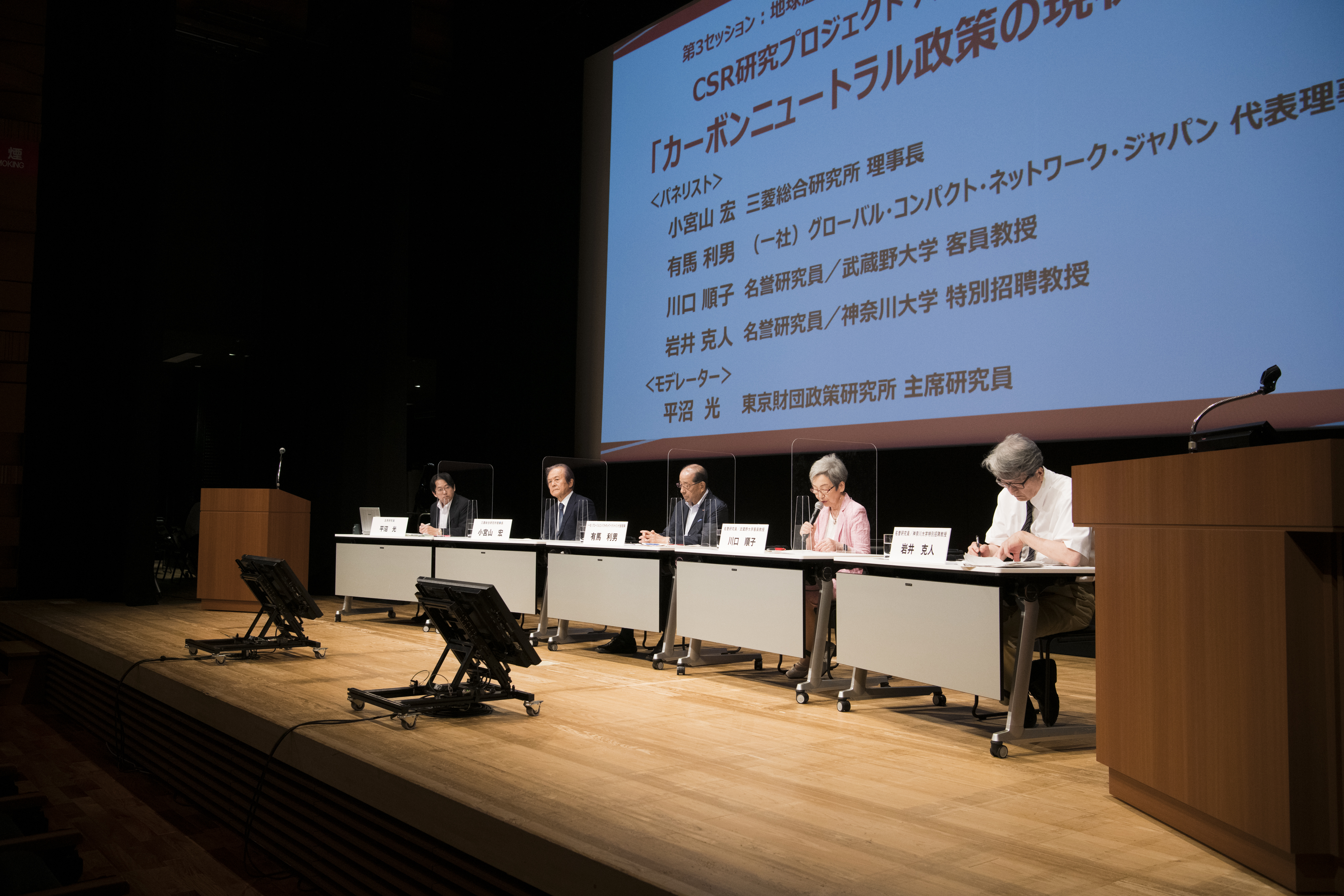
KAWAGUCHI: I’d like to address a question to Mr. Iwai. Policies for achieving carbon neutrality to stem global warming are oriented to the medium and long term. Even from Friedman’s perspective, you might say that such measures will help protect shareholder value in the long run, even if they don’t benefit the company right away. I wonder if CSR might be compatible with Friedman’s theories if we incorporate the element of time.
IWAI: I think Friedman would say that if environmental initiatives are oriented to long-term profits, then we should speak of them as activities to maximize long-term profits instead of using deceptive terms like CSR. But my view is that business corporations can have goals other than profit making, and CSR programs are precisely for that purpose. John Maynard Keynes famously said, “In the long run we are all dead.” But it’s a real limitation that businesses, like human beings, are only able to view things from a short-term perspective. That’s why we need to back their efforts toward carbon neutrality and provide a theoretical foundation for them.
HIKARU HIRANUMA (moderator): In the corporate survey carried out by the CSR research project, a relatively small percentage of companies said that the main reason they were pursuing carbon neutrality was because new markets were emerging or because they expected such markets to develop. It seems to me that we need a new mindset within Japanese industry. I guess it boils down to this question: There are so many things they could be doing. Why aren’t they doing them? Mr. Komiyama?
KOMIYAMA: A moment ago, someone mentioned the electric power crisis that hit the Tokyo area this past summer. And you’re quite right that it could have been avoided with a decent interconnection between Hokkaido and Honshu. If we ask ourselves what form Japan’s energy system should ultimately take, the answer is “a single, open nationwide grid that distributes nothing but carbon-free renewable energy.” The problem is, almost nothing is being done to achieve that vision.
We also wondered whether it was really possible to meet all of Japan’s energy needs with renewable energy, so we carried out some calculations, and we found that domestically produced solar cells and wind power alone could produce three times the amount of electric power currently generated in Japan. Solar power is the easiest to incorporate, but the form has to be adapted to the locale. In the Kanto region around Tokyo, installing solar panels on roofs is the most economically rational option. In Hokkaido, you’ll see more solar sharing using large plants built on farmland. But rooftop solar hasn’t really taken hold in the Kanto region. If we could just triple the amount of solar power generated in the region, it would probably be enough to avoid a crisis like we had this past summer.
Japan still has nine regional electric power companies, each with its own grid, and this is not in the best interests of the nation as a whole. It shows how little progress we’ve made since the March 2011 earthquake in terms of building a liberalized electric power market with a single, integrated grid. This is Japan’s biggest energy problem.
HIRANUMA: It seems that a lack of green infrastructure is one reason Japan is falling behind. At the same time, Japan has been slower than the West to adopt frameworks and strategies to promote the shift to clean energy. Mr. Arima, why do you think Japan is failing to keep pace with international trends?
ARIMA: Speaking from my experience as a corporate manager, I’ve seen recycling operations successfully incorporated into our core business. Recycling is an extremely painstaking and costly process, and companies that undertake it usually lose money in the short run. But here is what makes business management so fascinating. People who work on something that has social value find it interesting and rewarding, and that stimulates creativity and innovation. In our case, it led to a slew of patents, and we ended up operating in the black. People work hard when their work is rewarding. And when a business gets going on that basis, you’re making the company stronger and more profitable; it’s no longer a matter of sacrificing to meet ESG criteria. Once management shifts to this orientation, it transforms a company’s approach to CSR.
IWAI: Carbon-neutral policies will trigger changes in the industrial structure and the nation’s infrastructure, generating new business opportunities. This may seem to contradict what I said earlier about CSR, but Japanese businesses have been slow to pick up on these opportunities. One of the reasons for Japan’s three-decade-long stagnation is the habitual strategy of going small. While Japanese corporations are busy devising ways to save resources, Western venture businesses have been thinking up technologies that will eliminate the need to conserve. Japan’s problem is that it needs business leaders who can jettison the trimming-back approach and start over from square one, but its systems aren’t designed to produce that sort of talent.
KOMIYAMA: One of the dilemmas of innovation is that established companies have a tendency to squelch any new ideas that threaten to shake up their core business. That’s why it’s said that new companies have the advantage when it comes to innovation. I think this is a dilemma for Japan as a whole. Japan’s mainstream companies are too strong. Japan did well during the initial period of industrialization following the Meiji Restoration and again after World War II, when we were building something from nothing. But today, powerful, well-established businesses tend to quash innovation. We’ve seen some promising startups, but they tend to move overseas once they reach a certain size. Miniaturization has its place, but not as a national ethos.
IWAI: When the industrial structure shifts, gaps emerge that leave space for new things to be created. I’m hopeful that Mr. Taikan Oki’s lecture today will inspire more entrepreneurs to look for these business opportunities.
KAWAGUCHI: I agree that we’re entering an era of amazing opportunity. But not even former Prime Minister Suga’s pledge to cut greenhouse gas emissions to net zero by 2050 spurred any significant movement by Japanese businesses. The first reason is that they don’t see the seriousness of the problem. The second is that they don’t pay enough attention to what’s going on internationally. Japan’s biggest problem today is a lack of social vitality. We can’t break our habit of doing what’s expected of us, instead of what we want to do. Education is the key to changing that. We need to become a more risk-taking society.
ARIMA: The world’s leading global corporations, Japanese companies included, are working seriously toward carbon neutrality. If we look at corporate emissions data, we see that 70% of UNGC member companies are tracking their Scope 3 emissions. But the West keeps taking the initiative in formulating rules, such as the TCFD (Task Force on Climate-related Financial Disclosures) guidelines and Science Based Targets, so Japanese companies have their hands full keeping up with them. And no sooner do they catch up than the rules change again. Unless the Japanese government gets more involved in the process, our businesses are going to end up wasting a lot of effort. The government has an important role to play.
HIRANUMA: I’d like to wrap things up now with a final word or two from each of you.
IWAI: With social responsibility as a basic premise, I would like Japanese companies to seize the business opportunities offered by decarbonization. That means not being overly influenced by shareholder pressure to post short-term profits.
KAWAGUCHI: We’ve been emphasizing how far Japan lags behind, but the country is also quite advanced in certain areas. To make further progress, the government and private industry need to disclose more data, and everyone needs to recognize the seriousness of the problem and do their part to solve it.
ARIMA: Europe has taken bold steps to end its dependence on coal, but Japan has shown a lack of resolve. We have to decide what’s truly important.
KOMIYAMA: Right now, I’m deeply engaged in what you might call a forest industry initiative to promote a shift from petrochemical to biomass-based resources. There’s still hope for our country. Just one practitioner is worth a hundred experts. Putting theory into practice is going to be the key to meeting our 2050 emissions target.

